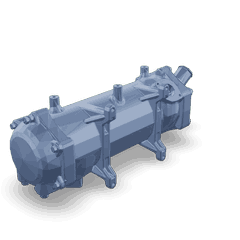This is an oversize product. Additional shipping fees may apply.
This truck part is made by Cummins®. We guarantee that all of our parts are from the OEM (original equipment manufacturer), ensuring a proper fit and quality manufacturing.
We honor the warranty provided by the original equipment manufacturer.
Introduction
The Cummins 5289417 Heat Exchanger is a critical component in commercial trucks, designed to transfer heat between fluids without direct contact. This process is essential for maintaining the optimal operating temperature of the truck’s engine and other systems, ensuring efficiency and reliability across various operating conditions 1.
Basic Concepts of Heat Exchangers
A heat exchanger is a system that transfers heat between two or more fluids at different temperatures. It operates on the principle of thermal conduction, where heat moves from the hotter fluid to the cooler one through a solid barrier. Types include shell and tube, plate, and air-cooled designs, each suited to specific applications across industries such as automotive, chemical processing, and HVAC 2.
Role of the 5289417 Heat Exchanger in Truck Operation
In truck operation, the 5289417 Heat Exchanger is vital for the cooling system. It transfers excess heat from the engine coolant to the ambient air, maintaining the engine’s temperature within a specified range. This prevents overheating, which can lead to engine damage, and ensures peak efficiency. It also helps the engine reach its optimal operating temperature more quickly and maintain it under varying load conditions 3.
Key Features
The Cummins 5289417 Heat Exchanger features high-quality, corrosion-resistant materials for durability in harsh environments. Its design maximizes heat transfer efficiency while minimizing pressure drop. Advanced fin designs and brazed construction enhance its effectiveness and reliability.
Benefits
Using the 5289417 Heat Exchanger in a truck’s cooling system improves engine efficiency by maintaining optimal temperature, leading to better fuel economy and reduced emissions. Its design and materials reduce maintenance requirements, enhancing the truck’s overall performance and longevity.
Troubleshooting and Maintenance
Common issues with the 5289417 Heat Exchanger include clogging, leaks, and reduced efficiency. Troubleshooting involves inspecting for damage, checking for leaks, and ensuring unobstructed airflow. Regular maintenance, such as cleaning fins and checking for corrosion, ensures optimal performance. Following manufacturer guidelines for maintenance intervals and procedures maximizes effectiveness.
About Cummins
Cummins Inc. is a global leader in designing, manufacturing, and distributing engines, filtration, and power generation products. With over a century of history, Cummins is known for innovation, quality, and customer satisfaction in the automotive and industrial sectors. The company is committed to advancing technology and providing reliable, efficient power solutions.
Compatibility and Integration
The Cummins part 5289417, a Heat Exchanger, is integral to the operational efficiency of several Cummins engine models. Specifically, this heat exchanger is designed to fit seamlessly with the QSB6.7 M CM2250 engine, ensuring optimal thermal management and performance. Its precise engineering allows it to integrate effectively within the engine’s cooling system, enhancing the overall functionality of the engine.
Additionally, the heat exchanger is compatible with other Cummins engines in the same series, ensuring a standardized fit across multiple models. This compatibility is crucial for maintenance and repair, as it allows for a consistent approach to servicing these engines. The design of the heat exchanger ensures that it meets the stringent requirements of Cummins’ high-performance engines, providing reliable and efficient heat transfer.
Role in Engine Systems
In engine systems, the 5289417 Heat Exchanger is integral to maintaining optimal operational temperatures. This component facilitates the transfer of thermal energy between two or more fluids without them coming into direct contact.
When integrated into an engine system, the heat exchanger works in tandem with the radiator, coolant system, and turbocharger (if present). It helps dissipate excess heat generated by the engine, ensuring that the coolant remains at an appropriate temperature. This temperature regulation is vital for the longevity and efficiency of the engine.
Additionally, in systems equipped with turbochargers, the heat exchanger plays a role in cooling the compressed air before it enters the combustion chamber. This process enhances the air density, leading to more efficient combustion and improved engine performance.
In diesel engine systems, the heat exchanger is often part of the exhaust gas recirculation (EGR) cooler. Here, it reduces the temperature of exhaust gases before they are recirculated back into the intake tract. This not only helps in meeting emission standards but also protects other engine components from the high temperatures associated with exhaust gases.
Overall, the heat exchanger is a key component in ensuring that engine systems operate within their designed thermal parameters, contributing to both performance and durability.
Conclusion
The Cummins 5289417 Heat Exchanger plays a vital role in the efficient operation of commercial trucks and Cummins engines. Its design and features ensure optimal heat transfer, contributing to engine efficiency, reliability, and longevity. Regular maintenance and adherence to manufacturer guidelines are essential for maximizing its performance and lifespan.
SPECIFICATIONS
RECOMMENDED PARTS
* Variable geometry turbocharger and electronic actuator repairs are not eligible to be claimed as over-the-counter under New or ReCon parts warranty for parts installed after October 1, 2018.
* Diesel Oxidation Catalyst (DOC), Diesel Particulate Filter (DPF), Selective Catalyst Reduction (SCR) catalyst, and Electronic Control Module (ECM) repairs are not eligible to be claimed as over-the-counter under New or ReCon parts warranty for parts installed after January 1, 2020.
* These restrictions are only applicable to New parts and ReCon parts coverages for the components listed above sold to a customer in the US or Canada. All other coverages are excluded. All other regions are excluded.









